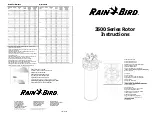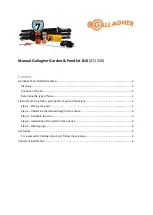
60
Re = (ρ) Lv/μ.
Reynolds Number (Re)
The Reynolds number has no unit of measure it is a pure number. As long
as Reynolds number is small, the flow remains laminar. When the Reynolds number becomes greater
than a critical value, the flow becomes turbulent. With rho {
ρ
}, L, and mu {
μ
} constant, Re varies
simply as velocity changes. For flow in smooth round pipes, critical value is about 2,000, with L equal to
the diameter of the pipe.
Pascal’s Law
In 1653, Blaise Pascal came up with the idea that in a fluid at rest, the pressure on
any surface exerts a force perpendicular to the surface and independent of the direction or orientation of
the surface. Any added pressure applied to the fluid is transmitted equally to every point in the fluid.
Pascal used his idea to invent the hydraulic press. Pascal’s principle is often used in devices that multiply
an applied force and transmit it to a point of application. Examples include the hydraulic jack, and the
pneumatic cylinder.
Gas Law
The actions of gases under varying conditions of temperature, pressure, and volume can
be described and predicted by a set of equations, or gas laws. These laws were determined by
measurements of actual gases and are valid for all substances in the gaseous state.
Measurements on gases were first published by Robert Boyle in 1660. He figured out that if an enclosed
amount of gas is compressed until it is half its original volume while the temperature is kept constant,
the pressure doubles.
Quantitatively, Boyle’s Law is:
PV = Constant
Where the value of the constant depends on the temperature and the amount of gas present.
Jacques Charles studied relationships between the temperature and volume of gases, while maintaining a
constant pressure. He saw a steady increase in volume as temperature increased, finding that for every
degree Celsius rise in temperature, the gas volume increased by 1/273 of its volume at zero degrees C.
Charles’s Law and Kelvin Temperature
Charles’s observations led to the absolute (Kelvin)
temperature scale, since the gas, according to the equation, would have zero volume at
–
273 degrees C.
Kelvin defined the absolute temperature scale so that absolute zero equals negative 273 degrees C and
each absolute degree is the same size as a Celsius degree. The modern value for absolute zero is
–
273.15 degrees C. This temperature scale allows Charles’s Law to be written
V/T = Constant, where V is
the volume of the gas, T is the temperature on the absolute scale, and the constant depends on the
pressure and the amount of gas present.
In 1802, Joseph Guy-Lussac experimented with the relationships between pressure and temperature and
came up w
ith an equation a lot like Charles’s Law:
P/T = Constant.
Generalized Gas Law
We can combine Boyle’s, Charles’s and Gay
-
Lussac’s laws to express this generalized
gas law:
PV/T = Constant,
Where the value of the constant depends on the amount of gas present and
t
is the absolute (or Kelvin)
temperature.
















































